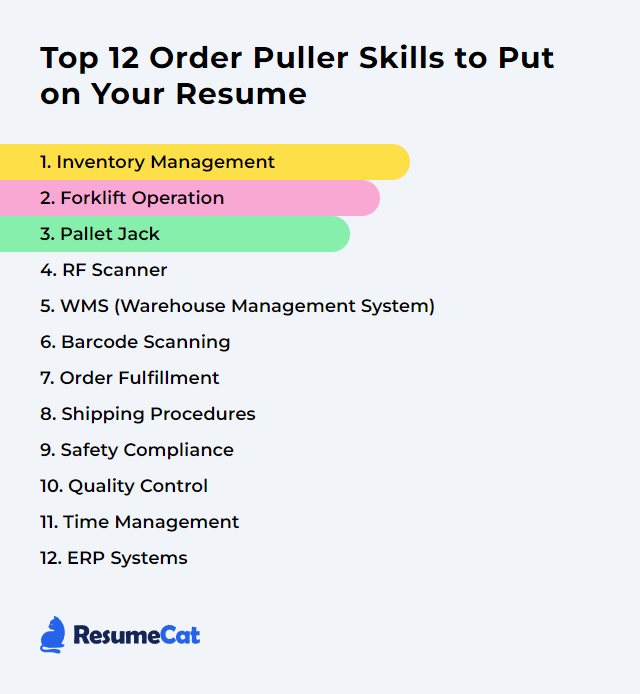Top 12 Order Puller Skills to Put on Your Resume
In today's warehouse grind, standing out as an order puller means showing more than strength and speed. It’s accuracy. It’s rhythm. It’s knowing the tools, the systems, and the small decisions that keep orders flowing without jams. Your resume should show that blend—technical skill, safety focus, and the instinct to keep the line moving.
Order Puller Skills
- Inventory Management
- Forklift Operation
- Pallet Jack
- RF Scanner
- WMS (Warehouse Management System)
- Barcode Scanning
- Order Fulfillment
- Shipping Procedures
- Safety Compliance
- Quality Control
- Time Management
- ERP Systems
1. Inventory Management
Inventory management for an Order Puller means tracking, organizing, and replenishing stock so the right items are ready to pick, pack, and ship—without delays or guesswork.
Why It's Important
It keeps orders accurate, shelves balanced, and workflow steady. Fewer stockouts. Fewer overages. Faster fulfillment and fewer headaches down the line.
How to Improve Inventory Management Skills
Sharper inventory control starts with clarity and speed. Try these:
Use real-time tracking: Keep counts live, not lagging. Update movements as they happen.
Adopt barcode or RFID scanning: Cut manual errors and move faster with every pick.
Streamline the layout: Place fast movers close to pack-out. Reduce travel time, boost output.
Apply ABC analysis: Label A/B/C by value and frequency. Prioritize your effort where it counts most.
Batch pick when it makes sense: Group similar orders and collapse repeat trips.
Keep training active: Short refreshers. Clear SOPs. Quick huddles to fix friction points.
Lean on integrated software: Use systems that sync sales and stock to keep levels honest.
Dial these in and the ripple effect is real: faster turns, fewer errors, happier customers.
How to Display Inventory Management Skills on Your Resume
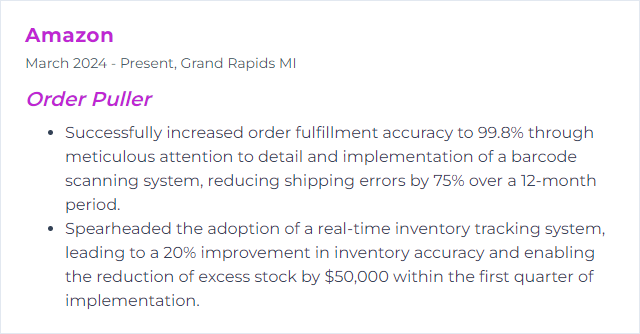
2. Forklift Operation
Forklift operation is the safe, efficient use of powered industrial trucks to move, stack, and retrieve goods for order fulfillment.
Why It's Important
It’s the backbone of movement in many warehouses. Done right, it speeds picking and protects products and people.
How to Improve Forklift Operation Skills
Small habits make big differences:
Get certified and stay current: Regular refreshers keep skills sharp and rules top of mind.
Do pre-shift checks: Brakes, forks, horn, battery/LP—catch issues before they snowball.
Maintain the fleet: Planned maintenance beats surprise downtime every time.
Plan routes and loads: Smart paths, balanced pallets, tight turns avoided.
Honor safety limits: Speed rules, capacity charts, clear aisles, eyes up for pedestrians.
Use WMS tasks: Let directed work guide priorities and reduce idle travel.
Communicate: Radios, hand signals, quick callouts—keep the floor in sync.
Result: fewer accidents, cleaner picks, smoother flow.
How to Display Forklift Operation Skills on Your Resume
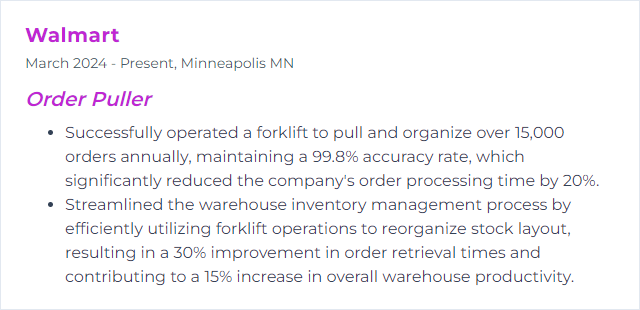
3. Pallet Jack
A pallet jack—manual or powered—moves pallets through tight aisles and short runs, letting an Order Puller handle heavy loads with control.
Why It's Important
It reduces strain, speeds staging, and safely shuttles product where forklifts aren’t practical.
How to Improve Pallet Jack Skills
Refine the tool and the technique:
Ergonomic handles: Better grip, less wrist fatigue, more precision.
Right wheels for the floor: Poly or rubber for smoother glide and quieter operation.
Adequate load rating: Match capacity to the job to avoid stalls and damage.
Maintenance kits on hand: Quick fixes keep the day from derailing.
Focused training: Safe angles, proper push/pull, tight-space maneuvering.
Helpful add-ons: Scales, brakes, and chocks boost control and speed.
Handled right, a simple jack becomes a quiet workhorse.
How to Display Pallet Jack Skills on Your Resume

4. RF Scanner
An RF scanner is a handheld device that reads barcodes, connects to your system, and guides picks, counts, and moves in real time.
Why It's Important
It slashes errors, speeds picks, and gives instant visibility into what moved and where it went.
How to Improve RF Scanner Skills
Make the device—and the workflow—work for you:
Keep software current: Updates improve speed, stability, and features.
Train smart techniques: Angle, distance, and sequence matter for fast reads.
Tune device settings: Brightness, sounds, and vibration for loud, low-light floors.
Clean and charge routinely: Wipe lenses, rotate batteries, replace worn grips.
Use ergonomic accessories: Holsters, straps, stands—less fatigue, more output.
Stabilize Wi‑Fi: Solid coverage prevents drops and rescans.
Fewer rescans. Faster confirms. Cleaner data.
How to Display RF Scanner Skills on Your Resume
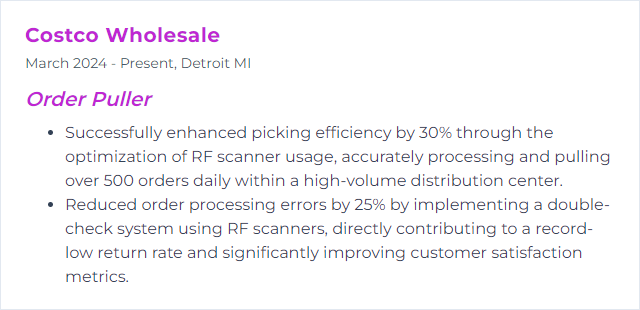
5. WMS (Warehouse Management System)
A Warehouse Management System coordinates receiving, slotting, picking, packing, and shipping—directing work and tracking inventory with precision.
Why It's Important
It reduces search time, guides the next best task, and catches mistakes before they escape the building.
How to Improve WMS (Warehouse Management System) Skills
Make the system your ally:
Sync real-time inventory: Live counts and immediate confirmations limit surprises.
Optimize pick paths: Directed routes shrink travel and boost lines picked per hour.
Use mobile devices: Scan, confirm, and move on without leaving the aisle.
Keep the UI simple: Clear labels, large buttons, minimal taps.
Train and retrain: Short, role-based sessions keep adoption high.
Automate data capture: Barcodes and RFID beat manual entry, every time.
When WMS fits the floor, order pullers fly.
How to Display WMS (Warehouse Management System) Skills on Your Resume
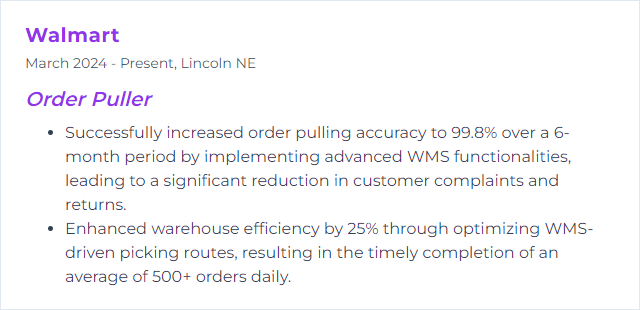
6. Barcode Scanning
Barcode scanning is the quick read-and-confirm step that ties products to orders, locations, and counts.
Why It's Important
It’s the gatekeeper of accuracy. One beep protects the rest of the process.
How to Improve Barcode Scanning Skills
Smoother scans, fewer misses:
Use reliable scanners: Fast reads at odd angles and distances save seconds all day.
Standardize barcode placement: Consistent, visible labels reduce hunting and flipping.
Improve lighting: Cut glare and shadows to boost first-pass reads.
Protect labels: Keep codes clean, covered, and scuff-free.
Coach technique: Wrist posture, aim, and pacing matter more than you think.
Use smart software: Validation rules and instant feedback prevent wrong-item scans.
Maintain equipment: Clean lenses, check triggers, replace worn cords or batteries.
Accuracy climbs. Picking speeds up. Returns drop.
How to Display Barcode Scanning Skills on Your Resume
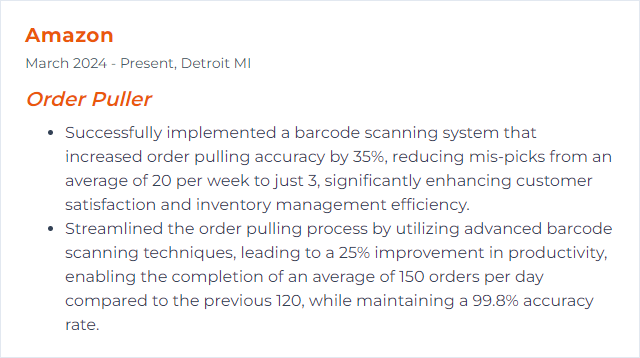
7. Order Fulfillment
Order fulfillment is the chain from pick ticket to packed carton: pulling the right items, verifying, and staging for ship-out.
Why It's Important
It defines the customer experience. On time, correct, intact—that’s the reputation maker.
How to Improve Order Fulfillment Skills
Trim friction. Add certainty.
Choose the right picking method: Batch, zone, or wave—match the strategy to order mix.
Lean on tech: Scanners and WMS keep picks honest and tracked.
Keep training fresh: Short modules and floor coaching beat once-a-year lectures.
Refine the layout: Put high-velocity SKUs up front and at ergonomic heights.
Add QA checkpoints: Quick verifications at pick and pack reduce rework.
Communicate in real time: Flag shorts, subs, and holds instantly.
Use ergonomic tools: Lifts, carts, and grips to save backs and seconds.
Review and iterate: Track errors and cycle times; fix the root, not the symptom.
Do this and orders stop being a scramble. They become a cadence.
How to Display Order Fulfillment Skills on Your Resume
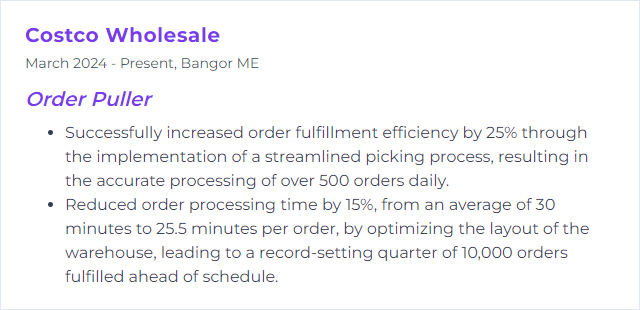
8. Shipping Procedures
Shipping procedures cover the final stretch: picking the right items, packaging securely, labeling correctly, and handing off to the carrier on time.
Why It's Important
This is where promises get kept. Clean labels, right service level, zero damage—customer trust hinges on it.
How to Improve Shipping Procedures Skills
Make the handoff seamless:
Automate where possible: Use WMS and shipping software to generate labels and confirm weights.
Scan at every handoff: Track who touched what and when.
Standardize packing: Clear guidelines for dunnage, tape patterns, and box selection.
Optimize staging: Sort by carrier, route, or cutoff to prevent missed trucks.
Keep counts accurate: Real-time inventory prevents shorts and mispicks.
Train and solicit feedback: The pack line knows where delays hide—listen and adjust.
Tidy process, fewer claims, smoother dispatches.
How to Display Shipping Procedures Skills on Your Resume
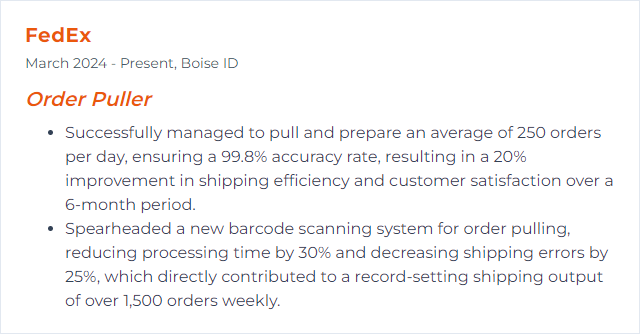
9. Safety Compliance
Safety compliance is following health, equipment, and workflow rules that keep people and products safe while pulling, moving, and staging inventory.
Why It's Important
It prevents injuries, protects uptime, and meets regulatory expectations. Safer floors are faster floors.
How to Improve Safety Compliance Skills
Build habits, not just checklists:
Role-specific training: Practical, scenario-based sessions that reflect real tasks.
Regular audits: Spot hazards early—fix cords, clear aisles, repair racking.
Right PPE, always: Gloves, eyewear, vests, and footwear that fit the work.
Clear, current policies: Simple SOPs, posted and reinforced, not hidden in binders.
Open reporting culture: Easy near-miss reporting without blame.
Continuous improvement: Track incidents, adjust workflows, upgrade gear.
Compliance isn’t a hurdle; it’s the path to smoother operations.
How to Display Safety Compliance Skills on Your Resume
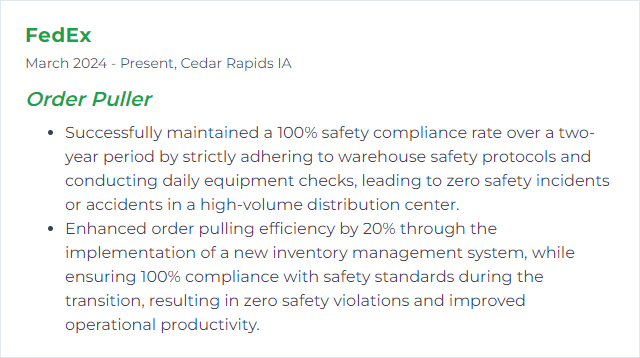
10. Quality Control
Quality Control for an Order Puller means verifying item, quantity, lot/serial (when needed), and condition before orders leave the building.
Why It's Important
Get it right the first time and returns drop, reviews rise, and costs stay in check.
How to Improve Quality Control Skills
Build reliability into the process:
Standardize work: Clear pick/pack steps with visual aids and checklists.
Train expectations: Define “done right” with examples and quick refreshers.
Use tech checks: Barcode confirmations and system prompts stop mismatches.
Monitor and coach: Sample checks, scorecards, and timely feedback.
Random audits: Catch drift before it becomes habit.
Listen to customers: Analyze returns and comments—fix root causes.
Recognize wins: Celebrate error-free streaks and high-accuracy performers.
Quality becomes muscle memory when the system supports it.
How to Display Quality Control Skills on Your Resume

11. Time Management
Time management is prioritizing picks, minimizing backtracking, and keeping pace with cutoffs—all while staying accurate.
Why It's Important
It unlocks higher throughput, steadier days, and fewer rushes at the dock.
How to Improve Time Management Skills
Trim the waste, keep the focus:
Prioritize early: Identify rush orders and tight SLAs at the start of the shift.
Batch similar tasks: Group picks by zone or SKU to cut travel time.
Use smart tools: WMS-directed work, pick paths, and live dashboards.
Set crisp goals: Break the day into blocks with targets you can track.
Keep areas tidy: Organized carts and clean aisles speed everything.
Keep learning: Short tips, peer ride-alongs, and quick process tweaks.
Less wandering. More winning. The clock starts working for you.
How to Display Time Management Skills on Your Resume

12. ERP Systems
ERP systems connect inventory, orders, purchasing, and finance in one platform, giving order pullers accurate item data, locations, and availability in real time.
Why It's Important
It aligns what’s promised with what’s on the shelf. Faster picks, fewer stock conflicts, cleaner handoffs to shipping and accounting.
How to Improve ERP Systems Skills
Make ERP a help, not a hurdle:
Integrate systems: Sync ERP with WMS, scanners, and e‑commerce to keep data consistent.
Customize roles: Tailor screens and permissions to the order puller’s daily flow.
Enable mobile access: Put essential functions on handhelds with fast, simple screens.
Train and support: Bite-sized guides, quick-reference cards, and responsive help.
Use analytics: Track pick accuracy, lines per hour, and stock discrepancies—then refine.
With the right setup, ERP becomes invisible—just solid, live data at your fingertips.
How to Display ERP Systems Skills on Your Resume

